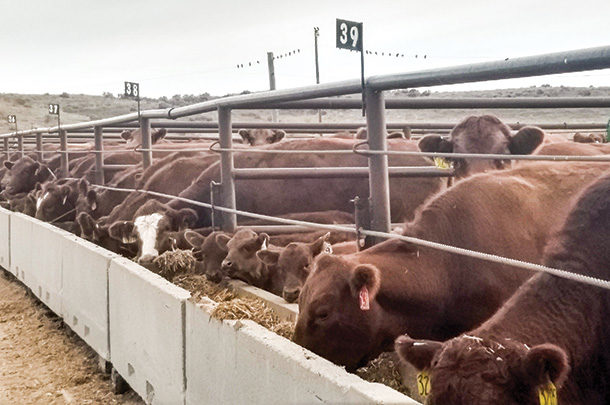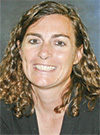What defines a fall-calving cow herd depends on the climate and resources available. Calving may occur from August to October in more northern climates and may be October to December on the Southern Plains.
Pros of a fall-calving herd
- One of the advantages of a fall-calving herd is that it allows producers to market calves opposite of the traditional spring-calving herd. Calf demand is often good when stocker or yearling operations are purchasing cattle for spring grass.
- Calving in mild weather is generally less labor-intensive for the producer.
- Illness is typically less in calves born in dry conditions than in calves born in cold, wet conditions.
- Integrated farming and ranching operations may be able to improve land utilization by using it for both crops and livestock. Those with limited perennial grass acres may find fall calving a beneficial way to use crop residues and annual forages.
Cons of a fall-calving herd
- A calf born in August may need shade as badly as a calf born in February needs shelter from the wind and cold. A newborn calf struggles to regulate its body temperature, and a calf born on a 100°F day may need shade. Producers who have the advantage of nighttime cooling in their environment may benefit the most from an August calving date.
- Most producers do not think about a calf, only a few days old, needing drinking water, but calves born in the heat may need a source of easily accessible water.
- A cow in peak lactation has double the energy requirement of a dry pregnant cow in midgestation. Therefore, available feed resources to maintain a lactating cow in the fall and winter months is a crucial part of the decision to have fall-calving cows.
- Because feed resources available in the fall and winter tend to be of lower-quality nutrition than spring grass, cows breeding in November through February may need supplementation or a carefully balanced diet to obtain an acceptable breed-back rate.
- Depending on feed resources and weather conditions, fall-born calves may not wean as heavy as their spring-born counterparts.
Nutritional considerations for a fall-calving herd
After weighing the pros and cons, climate and feed resources, a producer may opt to incorporate fall-calving cows into the operation. There are several management considerations and strategies that can help achieve optimum production.
As previously mentioned, the lactating cow has a high nutrient demand and must be fed accordingly. The young nursing calf also requires not only milk, but also high-quality feed to help develop the rumen as well as meet nutrient demands for growth. Bulls will also be working hard during the winter months and just like bulls in a spring herd, need to be in good body condition (5 or 6 on a 1-9 scale) before breeding and must receive adequate nutrition during breeding.
Crop residues and corn byproducts
Grazing crop residues can be an economical forage resource, but a lactating cow and her growing calf will need additional supplementation. This can often be supplied economically through corn byproducts, such as distillers grains. Fall pairs can also be maintained in confinement through the winter on a total mixed ration (TMR) based on ground crop residue and wet distillers.
Annual forages
Annual forages can be a great staple for the fall-calving herd. These may be planted as a second crop behind another crop – such as silage corn or wheat, planted in a forage chain of summer and winter annuals, or simply in a cropping rotation. Because of the nutrient content, they can be a great grazing resource for the breeding bull, the lactating cow and the growing nursing calf.
However, producers may want to consider rotational or strip grazing, as trampling losses can be substantial when cattle have access to the whole field at once. Annual forages also make good-quality silage and hay for the cow herd as well.
Management considerations for the fall-calving cow herd
Pairs will likely be fed in confinement at least part of the time in a fall-calving system. Limit feeding a nutrient-dense diet to meet the needs of cows while reducing cost by conserving dry matter has been shown to be effective in research studies.
However, when cows are limit fed, it is very important to provide 2 feet of feeding space per cow and 1 foot of feeding space per calf. Calves will likely need a diet more digestible than the cow diet if it contains a substantial amount of crop residue.
Commercial creep feeds can be expensive, so producers may want to consider a creep gate to allow calves access to their own feed and water or creep grazing. A creep area can be very beneficial for calves because it can be a place where they have their own shade or windbreak, accessible water, more-digestible feed and a place to rest away from cows. Congested areas can lead to an increased pathogen load, which can increase the incidence of illness in the calf, even when areas are drier than what is typical with spring weather patterns, making a creep area even more beneficial to the calf.
Early weaning as a tool for the cow and the calf
Another tool available to producers with fall-born calves is weaning earlier than the more traditional 180 to 210 days old in most spring-born herds. This allows the producer to develop a highly digestible diet specifically for calves, while returning the now non-lactating cow to a low-quality maintenance diet. This can be beneficial when green grass is not available yet, reducing the cost of the gestation diet compared to the previous lactation diet for the cow.
The young calf has been shown to be very efficient in feed conversion, often making the cost of gain very favorable. Pens should be secure enough to house the smaller, early weaned calf, and water and bunk space should be easy to reach.
A fall-calving herd can be a good way to improve land use and take advantage of market alternatives but must be carefully managed to control feed costs and maintain conception rates.









